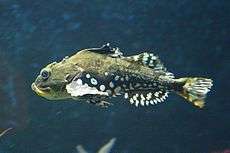Myoxocephalus scorpius
| Myoxocephalus scorpius | |
|---|---|
 | |
| Scientific classification | |
| Kingdom: | Animalia |
| Phylum: | Chordata |
| Class: | Actinopterygii |
| Order: | Scorpaeniformes |
| Family: | Cottidae |
| Genus: | Myoxocephalus |
| Species: | M. scorpius |
| Binomial name | |
| Myoxocephalus scorpius | |
| Synonyms | |
| |
Myoxocephalus scorpius is a species of fish in the family Cottidae. It is a demersal species of the Northern Atlantic and adjacent subarctic coasts, and of the Arctic including the coasts of Alaska and Siberia.[1][2] It has many common names, including shorthorn sculpin, bull-rout, goat sculpin, scummy, guffy, pig-fish, father-lasher, and horny whore.[3]
It reaches maturity at 15–30 cm (5.9–11.8 in) in length and specimens from the Arctic and subarctic, which grow to the largest size, can reach up to 60 cm (24 in). The fish has a squat appearance, a large spiny head and a tapering body. It is a mottled grey-brown in colour but can be darker, including black as base coloring. It has a large mouth and spiny gill covers.[1]
Shorthorn sculpin is found among seaweed or on rocky bottoms with mud or sand from 0 to 451 m (0–1,480 ft).[1] In arctic regions they can also be found in tidal pools. They feed on a wide range of demersal and benthic fishes and crustaceans.[4]
Myoxocephalus scorpius is not venomous, but it can be mistaken for similar looking venomous fishes, such as those in the scorpionfish family.[5]
The shorhorn sculpin spawns in December through March, the eggs being laid on between rocks in a clump protected by the male. They usually hatch in five weeks.[3]
References
- 1 2 3 Froese, Rainer and Pauly, Daniel, eds. (2006). "Myoxocephalus scorpius" in FishBase. April 2006 version.
- ↑ Shorthorn Sculpin, Myoxocephalus scorpius Canada's Polar Life: Organisms. www.polarlife.ca
- 1 2 Garcia, S. 2015. Myoxocephalus scorpius. The IUCN Red List of Threatened Species 2015. Downloaded on 21 August 2018.
- ↑ The Pocket Guide to Saltwater Fishes of Britain and Europe
- ↑ Horton, A. Terror of the Rock Pool. British Marine Life Study Society.
| Wikimedia Commons has media related to Myoxocephalus scorpius. |
